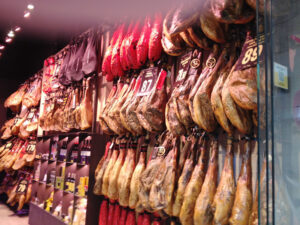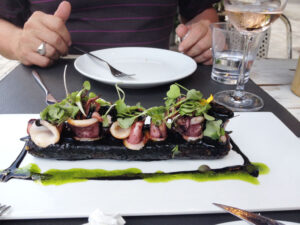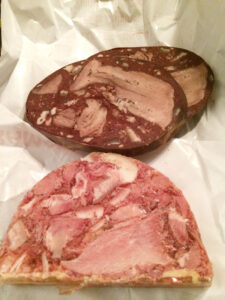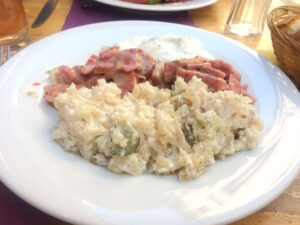Adventure on a Plate
By Michele Reed
Email: bazanreed@hotmail.com
Photos by Bill Reed

There’s a thing going around on Facebook. It’s a list of foods considered weird, and you’re told to give yourself a point for every one of them you’ve eaten.
Now anyone who’s eaten a meal with me recently will attest to the fact that, as I get older, I avoid a lot of foods, especially those with spices that trigger heartburn. No sriracha for this lady. Jalapenos? Nada.
But often I score highly on that Facebook quiz, 20 to 22 out of 24. You see, I wasn’t always so finicky. And on family road trips around America, and later, international travels with my late husband, Bill, we were always up for the local specialty.
In America it was easy: lobster rolls in Kennebunkport and soft-shell crabs in Baltimore. On our “barbecue tour of America,” we savored local varieties — like burnt ends of brisket in Kansas City and sweet red pork barbecue and white bread in Memphis.
We had pasties (little meat and potato hand-pies full of turnips and cabbage) on the Upper Peninsula of Michigan, and scrapple in Lancaster, Pennsylvania.

When Bill and I started our journeys sans kids, that’s where the menu really got interesting: I enjoyed the alligator sausage so much in New Orleans (not to mention the alligator and crawfish etouffee) I convinced Bill to try it in Florida. “Tastes like chicken” is a cliché, but in this case, it’s true.
One memorable meal on our Alaskan journey was reindeer sausage for breakfast. As I recall, Bill’s uncle from Fairbanks didn’t tell us we were eating Prancer until we were done.
Things got even more interesting — and adventuresome — when we headed to Europe. I’m Polish, so I didn’t consider it odd to have pickled fish and kielbasa on a breakfast buffet there, and tiny fried pierogi, eaten on the streets of Warsaw. Or tripe soup, followed by shots of ice-cold cherry vodka, swallowed in one gulp.

When we got to Scotland, we were eager to try haggis. The national dish of Scotland, haggis is a mélange of sheep’s heart, liver and lungs, mixed with oatmeal, onions, suet and spices, cooked in a sheep’s stomach. It’s hardly a mouth-watering image. But we wouldn’t be deterred, and washed down with a pint of Scottish ale, it really hit the spot.
Barcelona saw us venture further afield, as Catalan recipes draw from their peasant roots and that means nothing is wasted. One local restaurant — quite upscale with crystal chandeliers, silver and linens — nonetheless served up a steaming bowl of pigs’ ears, trotters and snouts, parts of the animal most often thrown away here. But then my Polish grandmother made her own head cheese with those same ingredients molded in a gelatin base, so I wasn’t shocked by the Spanish stew.
Another favorite was arroz negro, basically a bowl of rice swimming in black squid ink and cuttlefish.
I came to love octopus and fried baby squid, tentacles and all, and pescaito frito — tiny fish fried up and served in a paper cone. They were an addictive treat during tapas hour.
Speaking of cones, in Barcelona, you can go into the Boqueria market and come out with one filled with shavings of dry serrano ham, cut from a pig’s leg hanging with dozens of others on the wall, hoofs and all. Choose the one with the black hoof. It’s a wild pig, feeding on acorns in the foothills of the Pyrenees and considered a true delicacy, with a price to match.
When we settled in France, a whole new world of food some might consider adventuresome at best, and weird at worst, awaited us.

It’s a cliché that the French eat snails, but we had to try them, sauteed in garlic. They were wonderful. Foie-gras is a staple, and we enjoyed it cold, spread on crusty baguette, or fried in a pan and served on salad as an appetizer. Anyone who grew up with fried liverwurst, as I did, knows how good that tastes with a light sear.
We had mussels on the beach in Banyuls-sur-Mer, anchovies from the Mediterranean in Collioure, and bouillabaisse, or hearty fish stew, on the harbor at Marseille, where it originated.
Monsieur Ramos, the butcher in our village, took it upon himself to stretch our culinary horizons. We tried his homemade merguez, a spicy lamb sausage from Morocco, and boudin noir, a dark blood sausage, one of his specialties. The boudin noir reminded me of Polish kiszka, a blood sausage made with barley. There was head cheese and pate made from pork liver, chickens with the head and feet still on and fatty duck breast to sauté.
One day, he handed me a package of kidneys for free, along with his advice on cooking them. Apparently, I didn’t do a very good job. Not only did they stink up the entire house, they also tasted terrible. I told him, “I preferred the liver,” and was greeted with hearty laughter.
Two things I drew the line on, however. One was tiny pig brains, nestled in a tray. The other was horse meat, although he loved to tease me and Bill about it. “You Americans don’t know what’s good,” he would say.
I do know one thing: There’s a lot of adventure to be had in this world. And much of it is available on a plate.

